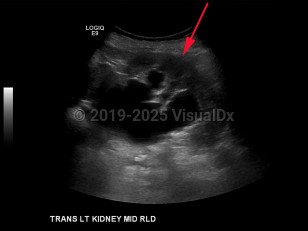Hydronephrosis in Adult
Alerts and Notices
Important News & Links
Synopsis
Nephrolithiasis, prostatic hypertrophy or carcinoma, and retroperitoneal or pelvic neoplasms are the most common causes of hydronephrosis in adults. In children, hydronephrosis is most often secondary to an anatomic abnormality such as posterior urethral valves, vesicoureteral reflux, or ureteropelvic junction (UPJ) obstruction. Bilateral hydronephrosis is most often secondary to bladder tumors that obstruct the outflow of urine. In women, this can be caused by uterine, cervical, or ovarian cancer. Congenital anomalies account for a higher incidence of hydronephrosis in children compared to adults.
The Society for Fetal Urology has developed a grading system for severity of hydronephrosis. Grades range from 0-4; grade 0 is the most mild with no renal pelvis dilation, and grade 4 is the most severe and is characterized by dilation of the renal pelvis and calyces and thinning of the renal parenchyma.
Patients with isolated hydronephrosis are typically pain free; the presence of pain is usually in the setting of stones, acute bladder distension, or infection. Upper ureteral or renal pelvic lesions typically cause flank pain, whereas lower ureteral obstruction causes pain that radiates to the ipsilateral testicle or labia. Other presenting symptoms include hypertension, change in urine output, hematuria, or new creatinine elevation on routine laboratory studies.
Codes
N13.30 – Unspecified hydronephrosis
SNOMEDCT:
43064006 – Hydronephrosis
Look For
Subscription Required
Diagnostic Pearls
Subscription Required
Differential Diagnosis & Pitfalls

Subscription Required
Best Tests
Subscription Required
Management Pearls
Subscription Required
Therapy
Subscription Required
Drug Reaction Data
Subscription Required
References
Subscription Required
Last Updated:11/21/2019

